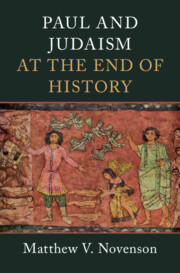11 results
5 - Artificial Intelligence and Jewish Thought
- from Part I - Religions and AI
-
-
- Book:
- The Cambridge Companion to Religion and Artificial Intelligence
- Published online:
- 20 November 2024
- Print publication:
- 21 November 2024, pp 69-87
-
- Chapter
- Export citation

Paul and Judaism at the End of History
-
- Published online:
- 23 October 2024
- Print publication:
- 10 October 2024

A Documentary History of Jewish–Christian Relations
- From Antiquity to the Present Day
-
- Published online:
- 03 October 2024
- Print publication:
- 17 October 2024

Multilingualism and Translation in Ancient Judaism
- Before and After Babel
-
- Published online:
- 01 August 2023
- Print publication:
- 21 September 2023
8 - A Bad Man Theory of Religious Law (Numbers 15:30–31 and Its Afterlife)
- from C - Legal-Theological Roots
-
-
- Book:
- Law as Religion, Religion as Law
- Published online:
- 11 August 2022
- Print publication:
- 25 August 2022, pp 197-224
-
- Chapter
-
- You have access
- Open access
- HTML
- Export citation
15 - The Severans and Rabbi Judah ha-Nasi
- from Part III - Ethnicity and Identity in the Roman Empire
-
-
- Book:
- Rome: An Empire of Many Nations
- Published online:
- 14 April 2022
- Print publication:
- 21 April 2022, pp 260-272
-
- Chapter
-
- You have access
- Open access
- HTML
- Export citation
15 - The Severans and Rabbi Judah ha-Nasi
- from Part III - Ethnicity and Identity in the Roman Empire
-
-
- Book:
- Rome: An Empire of Many Nations
- Published online:
- 04 August 2021
- Print publication:
- 23 September 2021, pp 260-272
-
- Chapter
- Export citation
5 - Translation and/as Rewriting
-
- Book:
- Genres of Rewriting in Second Temple Judaism
- Published online:
- 05 June 2020
- Print publication:
- 11 June 2020, pp 137-168
-
- Chapter
- Export citation
Chapter 8 - What Is the Bavli?
-
- Book:
- A History of the Talmud
- Published online:
- 18 July 2019
- Print publication:
- 03 October 2019, pp 144-178
-
- Chapter
- Export citation
Chapter 1 - Introduction
-
- Book:
- A History of the Talmud
- Published online:
- 18 July 2019
- Print publication:
- 03 October 2019, pp 1-14
-
- Chapter
- Export citation

A History of the Talmud
-
- Published online:
- 18 July 2019
- Print publication:
- 03 October 2019

